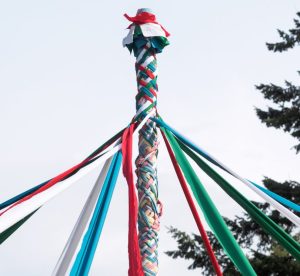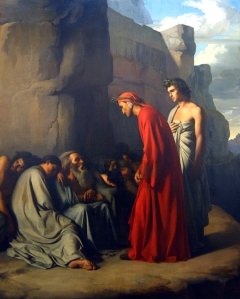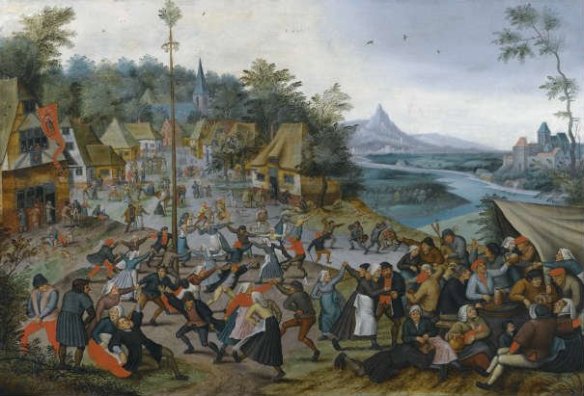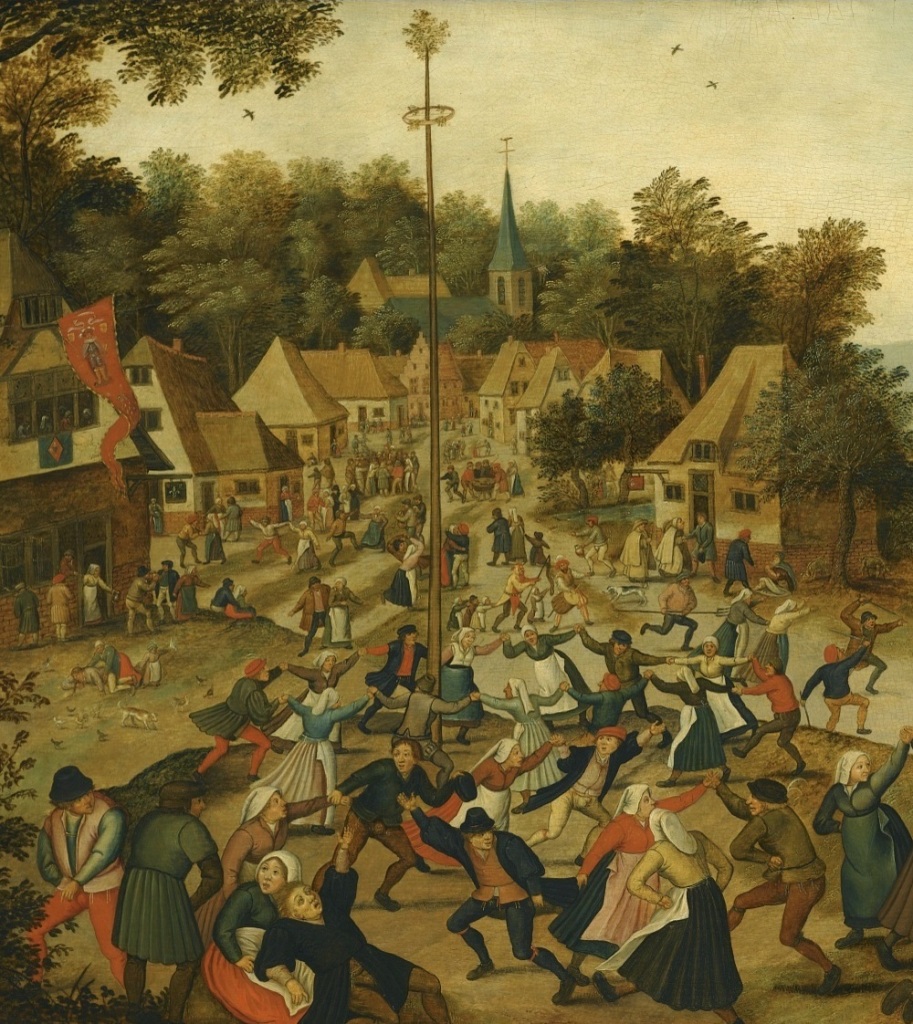Maypole
The maypole is a symbol of the Tree of Life and by extension the Tree. It is cut and used in celebrations in early Spring when plant life is just starting to become abundant again, in effect when life is regenerating. The custom is to be found from Scotland and Sweden to the Pyrenees and Slav countries.
The time when the maypole is brought in depends on the place because, being symbolic of new life, it is cut when life is at its most regenerative. Spring occurs in different months in different parts of the world, so in the UK and Saxony, for example, it is generally cut on the 1st May; in the Vosges it is the first Sunday of May; in Sweden it is the Summer solstice.

“Village Scene with Dance around the May Pole” by Pieter Bruegel The Younger.
 All over the UK and Europe an actual tree trunk used to be used as the maypole, usually stripped of its branches, sometimes – as in Saxony for example – a few branches were left on the top and laden with gifts – often eggs and other cosmic symbols, sometimes toys [treasure] and flowers. The participants occasionally tried to climb the tree to get the presents. An extension to the maypole was also the slippery pole which has the same symbolic root. The slippery pole and the smooth shaft of the maypole with its presents or treasure at the top both symbolically show the unattainability of the treasures of the spiritual realm.
All over the UK and Europe an actual tree trunk used to be used as the maypole, usually stripped of its branches, sometimes – as in Saxony for example – a few branches were left on the top and laden with gifts – often eggs and other cosmic symbols, sometimes toys [treasure] and flowers. The participants occasionally tried to climb the tree to get the presents. An extension to the maypole was also the slippery pole which has the same symbolic root. The slippery pole and the smooth shaft of the maypole with its presents or treasure at the top both symbolically show the unattainability of the treasures of the spiritual realm.
Many shamans in slavonic countries used to actually climb the ropes fastened to the pole in a symbolic act representing an ascent to heaven – the spiritual path.


Occasionally the old tree is burnt and a new tree replaces it. This is symbolic not of the destruction of the cosmic Tree of Life, but of the Tree – man’s body. It was used as a symbol of reincarnation as the ashes of the burnt tree were also used to fertilise the fields and this action helped to reinforce the symbolism – new life from old.

Frederick Goodall – “Raising the Maypole” 1855
Maypole dancing
Maypole dancing is a form of folk dance from western Europe, especially England, Basque Country, Finland, Sweden, Galicia, Portugal and Germany.
The maypole is used but extra symbolism is obtained from the link with the Celestial pole and the Cone.
Note:

Cone: The Levels and layers are divided up into a massive number of cones of Spirit. Another way of looking at this may be to think of them as shards of Spirit or Pyramids of programmed Energy. Each cone belongs to a physical thing, so you me, a tree , a plant a dog, a flower and so on, each thing has its own cone of energy. Part of the cone is perceptible – in effect we can perceive it with our 5 senses. But a large part of it is not perceptible because it is of a higher level of vibrational Energy.
Other terms for this ‘pole’ include the ‘Axis Mundi’ or ‘World Axis’ or ‘Cosmic Axis’ or ‘Cosmic Tree’.

The pole itself is the Celestial pole, however, the Maypole is often danced round using ribbons that form a cone shape.
Dancers gather in a circle, each holding a coloured ribbon of contrasting colours attached to the pole. On the tip of the pole we have the spray of flowers or ribbons that symbolises the Higher spirit and the crown chakra.
 The dancers form a cone shape and as the dance commences the ribbons are intertwined and plaited either on to the pole itself or into a web around the pole. So we have the symbolism of the loom or net incorporated. The dancers may then retrace their steps exactly in order to unravel the ribbons. May as a tree has its own symbolism – the white flowers and bright green leaves signalling Spring, either the start of the Spiritual cycle – so the start of life’s journey and the Spiritual path or the very end of it. Thus the added symbolism derives from the ascent up the Spiritual path in a spiral – the sort of journey Dante took up the mountain.
The dancers form a cone shape and as the dance commences the ribbons are intertwined and plaited either on to the pole itself or into a web around the pole. So we have the symbolism of the loom or net incorporated. The dancers may then retrace their steps exactly in order to unravel the ribbons. May as a tree has its own symbolism – the white flowers and bright green leaves signalling Spring, either the start of the Spiritual cycle – so the start of life’s journey and the Spiritual path or the very end of it. Thus the added symbolism derives from the ascent up the Spiritual path in a spiral – the sort of journey Dante took up the mountain.


Some of the older original maypole ceremonies used large trees shaped like a cross at the top of which were goodies – treasure.

“St. George’s Kermis with the Dance around the Maypole” by Pieter Brueghel the Younger
Patterns in Comparative Religion – Mircea Eliade
In Saxony the ceremony took place on May 1st or Whitsunday, and consisted first in bringing young trees from the forest to decorate the houses, then in setting up one tree, the May, solemnly in the centre of the village. Its branches were cut off, except perhaps a few of the topmost ones which were laden with gifts (sausages, eggs, cakes). Then young men competed, in some regions, to see who could most quickly climb to the top, in others, who could run quickest to where the Maypole stood. Sometimes there was a race on horseback. The winner was borne shoulder high and given honours. At one time he was presented with a red cloth by the prettiest girls.
Such a lot of symbolism! Climbing the Celestial pole is thus ascent up one’s spiritual path to try to find Treasure, the red cloth is the path of the Sun –

Ostereierbaum Easter Egg Tree
A German tradition of decorating trees and bushes with Easter eggs is known as the Ostereierbaum, or Easter egg tree.
Patterns in Comparative Religion – Mircea Eliade
in a great many places the egg is connected with the symbols and emblems of renovation ……; the new year trees, maypoles, Saint John’s trees and so on, are decorated with eggs and egg-shells…
At the end of the cycle – life’s journey, one hopes one has achieved one’s Destiny, which means that the body is no longer needed or the cone, because your soul ascends up the cone and joins with the Higher spirit on death.
 Thus whenever a new May tree is used for the ceremonies it is time for the old one – the ‘body’ to be burnt . Here we see a host of additional symbolism being brought into play – cremation, bone and bonfires. This is because the tree essentially represents a single person [one cone] and in ths case the trunk of the tree is symbolically the person’s spine.
Thus whenever a new May tree is used for the ceremonies it is time for the old one – the ‘body’ to be burnt . Here we see a host of additional symbolism being brought into play – cremation, bone and bonfires. This is because the tree essentially represents a single person [one cone] and in ths case the trunk of the tree is symbolically the person’s spine.

There is some connection with the Mypole and the Christmas tree.

Here we see this along with some literalisation of the symbolic, ash has its own symbolism
It is used for people on the spiritual path. Having been symbolically through Fire one has emerged Balanced [the combination of Black and White] and has been reduced symbolically to Dust. In effect one has completed the spiritual path and been annihilated – achieved Annihilation.
Patterns in Comparative Religion – Mircea Eliade
In the Vosges, the ceremony takes place on the first Sunday of May. In Sweden, they bring a ‘Maypole’ into the house generally at the summer solstice; it is a fir tree with its branches stripped off, decorated with artificial flowers and toys and so on. Wherever this custom is found – from Scotland and Sweden to the Pyrenees and the Slav countries – the ‘Maypole’ gives an occasion for general jollity ending with a dance round the pole. The chief part is usually played by young people or children. It is a feast of spring but, like all such manifestations, can turn into something of an orgy……….
In many places when the Maypole is solemnly carried in, the previous year’s tree is burnt. The consumption of the wood by fire is probably another rite of … regeneration … for in India and in classical antiquity a tree was ceremonially burnt at the new year. This celebration, with the burning of the tree, was often in India the occasion of an orgy; the Bihars of the United Provinces (Agra and Oudh) for instance, set fire to the salmali tree, and then gave themselves over to a collective orgy. The ash of the tree is full of apotropaic and fertilising qualities. It wards off sickness, the evil eye, and evil spirits. In Europe the ashes remaining from the burnt Maypole, or firebrands from it, are scattered about the fields at Christmas or Carnival time to improve and multiply the crops.

